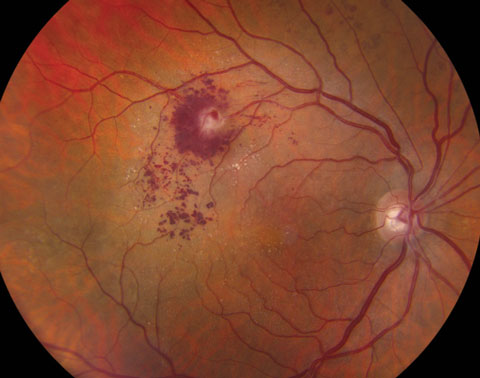 |
|
Nonsurgical clinical management of RAM can achieve VA improvement. Photo: Angela Diamantakos, OD. |
Currently, there are no standard treatment guidelines for retinal arterial macroaneurysm (RAM). Proposed management options include observation, laser photocoagulation, anti-VEGF therapy and surgery. RAMs are considered self-healing, so nonsurgical management is often considered the preferred treatment, as it does not have technical limitations. However, the results of different strategies can vary. A recent study published in BMC Ophthalmology explored changes in logMAR visual acuity (VA) and central retinal thickness associated with several treatment options. The researchers found that observation, laser photocoagulation and anti-VEGF therapy were all effective management methods for RAM. Notably, laser photocoagulation was an effective treatment for exudative RAM, and anti-VEGF therapy offered improved outcomes for patients with severe VA and central retinal thickness.
The study included 14 patients from a hospital setting and 210 patients from a literature review. VA and central retinal thickness in patients who underwent observation, laser photocoagulation and anti-VEGF significantly improved from baseline, with logMAR VA improving by -0.34, -0.17 and -0.45, respectively. Central retinal thickness also improved with each method by -148.26µm, -185.61µm and -287.45µm, respectively.
Anti-VEGF therapy was used in patients who had worse VA than those who underwent laser photocoagulation but achieved better improvement in VA than the laser photocoagulation group. Patients treated with anti-VEGF also had thicker central retinal thicknesses than the observation group and experienced better changes in that parameter than the observation and laser photocoagulation groups. These patients were characterized by severe development of RAM, which is distinguished by obvious hemorrhage and edema, resulting in a significant decline in vision. For these patients, observation and laser photocoagulation may not directly eliminate subretinal hemorrhage or macular edema.
“Although observation is the most conservative method for RAM management, it may not be a safe method when there is a risk for RAM rupture or RAM with severe hemorrhage and exudates,” the researchers noted.
“All management strategies should consider the unique needs of each patient,” the team concluded. “Nevertheless, observation, laser photocoagulation and anti-VEGF therapy are all effective management methods for RAM.”
Wang Y, Du H, Zhao X, et al. Observation, laser photocoagulation or anti‑VEGF therapy in the management of retinal arterial macroaneurysms. BMC Ophthalmol. November 2, 2022. [Epub ahead of print]. |

